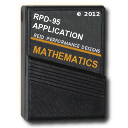The Number Theory Program
Each of the selections in this program treats a number as a combination of integers. The program derives its results from comparisons of the divisors of numbers. Numbers that have no divisors in common are relatively prime.
Introduction
The number theory program has five selections that involve relatively prime numbers, divisors, congruence, and ratios.The program can determine how many of the integers less than the given integer are relatively prime (have no factors in common with the number). For example, 9 has six relative primes, 1, 2, 4, 5, 7, and 8.
The program can calculate how many numbers are a divisor of a given number. It can also provide the sum of the divisors. For example, the six divisors of 12 are 1, 2, 3, 4, 6, and 12, which total to 28. Outside this program, the calculator can perform other divisor calculations, available from the keyboard.
The program has an option to perform congruence calculations. The congruence of two numbers depends on the modulus you specify. A modulus of 7, for example, causes 12 and 19 to be congruent (both are 5 greater than a multiple of 7).
The standard expression for congruence is ax ≅ b (mod m), which states that for modulus m, ax and b are congruent. The program finds the values of x ≤ m such that frac ( ( ax - b ) ÷ m ) = 0. For example, if you enter a = 3, b = 19, and m = 7, the program results in x = 4.
The final option of this program is the search for two integers whose ratio approximates the given value within a specified error. For example, 3.375 is equal to 27/8.
The Number Theory Menu
When you select { NUM } from the MATHEMATICS menu, the calculator displays:
The NUMBER THEORY menu enables you to select from the following options.
{ phi } - Performs the Φ(n) calculation.
{ d } - Performs the σ0 calculation.
{ sig } - Performs the σ1 calculation.
{ CON } - Runs the Congruence program.
{ RAT } - Runs the Rational Approximation program.
☚ Back


